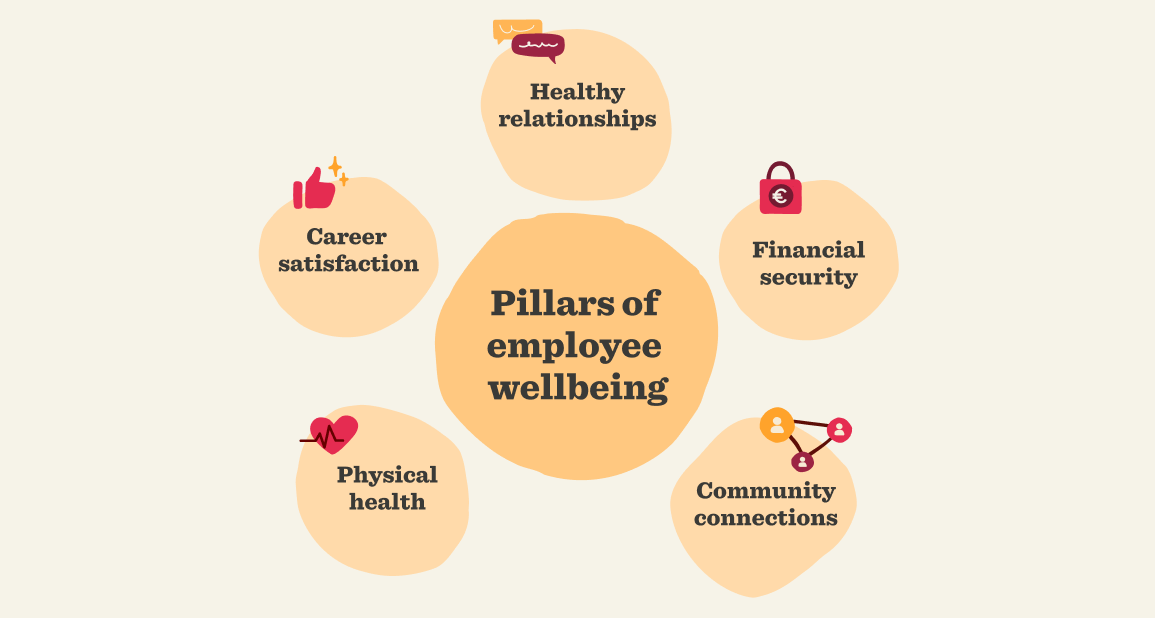Employee wellbeing refers to a professional’s holistic state of mental, emotional, and physical health. According to Gallup researchers, employee wellbeing includes five core components:
- Career wellbeing. The satisfaction people feel with work responsibilities and how they spend their time at work every day.
- Social wellbeing. Engaging in healthy, meaningful relationships with friends and family.
- Financial wellbeing. Being able to manage personal finances successfully.
- Physical wellbeing. Having health and energy for basic functioning and accomplishing tasks.
- Community wellbeing. Having a connection with others and feeling a sense of belonging in the place you live.
Why should HR leaders care about employee wellbeing?
As guardians of a company’s most valuable asset—its people—employee wellbeing should be a priority for HR.
Wellbeing goes beyond health. It indicates that people are thriving holistically, functioning optimally, and actualizing their potential in their personal lives and at work.

What are the advantages of employee health and wellbeing?
Wellbeing can support mental stamina, emotional intelligence, and resilience—three soft skills necessary for productivity, creativity, and efficiency.
Thus, employee wellbeing is the bedrock of high-performance work, a thriving workforce, and a successful business.
Employee wellbeing largely contributes to:
- Goal achievement
- Risk taking
- Finding practical, intelligent solutions to challenges that arise
- Decreased absenteeism
- Increased retention and engagement
- Reduced healthcare expenses
- A thriving company culture
What can HR leaders do to promote employee wellbeing?
If you want to make your people’s wellbeing a priority, make it part of your company culture. While everyone must take care of their health, HR can encourage wellbeing by emphasizing it as a work value. Here are three ways to infuse wellbeing into your company’s approach to work:
- Balance work with play. While maintaining workflow is necessary for productivity, people aren’t robots. To have energy for work, there must be time for play. Organizing mood-boosting, community-building, and social gatherings, such as staff hikes or park picnics, gives people a chance to recharge and reconnect.
- Cultivate gratitude. HR leaders can encourage camaraderie and meaningful work experiences by recognizing and thanking people for their hard work and accomplishments. Communicating appreciation infuses good vibes and meaning into the work community.
- Encourage mindfulness. Mindfulness sets the foundation for smart decision-making, high-quality work, better communication, and thinking outside the box. Making mindfulness a habit helps people regulate their emotions and thoughts. Teams can practice mindfulness through group breathing exercises or meditations before conducting a meeting. To support mindfulness on an individual level, companies can designate a room or garden as a tech-free zone for people to have quiet, uninterrupted alone time.
What are some tips for building effective employee wellbeing programs and initiatives?
While it may be tempting to integrate a generic wellness program, try to consider your company’s specific needs. You can do so by:
- Identifying the problem areas. These may include burnout, lack of purpose and drive, and work-life imbalance.
- Evaluating the major barriers to wellbeing. Perhaps there is poor management, too heavy a workload, or a misalignment of core company values preventing people from achieving a state of wellbeing.
- Assessing the cost of low employee wellbeing. How does a lack of wellbeing affect productivity and the bottom line?
- Planning a wellbeing program. What actions is your company currently taking to promote wellbeing, and how do these initiatives compare with internal and external benchmarks?
- Implementing a customized wellness program. The wellness program should provide practical, tailored solutions for staff, addressing their challenges and different life stages. The program could include, for example, an Employee Assistance Program (EAP), coaching and mentorship opportunities, or personal financial advising opportunities.
Recommended For Further Reading
How can you effectively measure employee wellbeing?
Wellbeing is integrative, so you’ll need to gather all pieces of the wellbeing puzzle to see the complete picture. Let’s look at some ways to assess and measure wellbeing:
- Gather feedback through pulse surveys. By asking the right questions, HR can narrow in on team members’ state of wellbeing. Questions that relate to one specific issue and give people the option to rate how they’re feeling on a scale can provide helpful answers. Open-ended questions can also offer insight, but make sure you have the time and resources to read and address each answer. Surveys can include questions that touch on topics such as compensation, engagement, belonging, workload, and career goals.
- Keep track of workforce data. While data doesn’t reflect a person’s internal struggles, it can illustrate challenges such as a high rate of absenteeism or low productivity— signs of a potential underlying issue.
- Brief check-ins. HR or managers can routinely meet with professionals. Getting together to talk, whether in person or through video chats, can provide feedback that may not have been apparent through surveys and data.
How can employee wellbeing improve company culture?
Thriving people make up a thriving company culture. When each part of the whole—each person—is in a state of wellbeing, they can work productively, collaborate effectively with team members, and contribute to a positive and vibrant culture.
